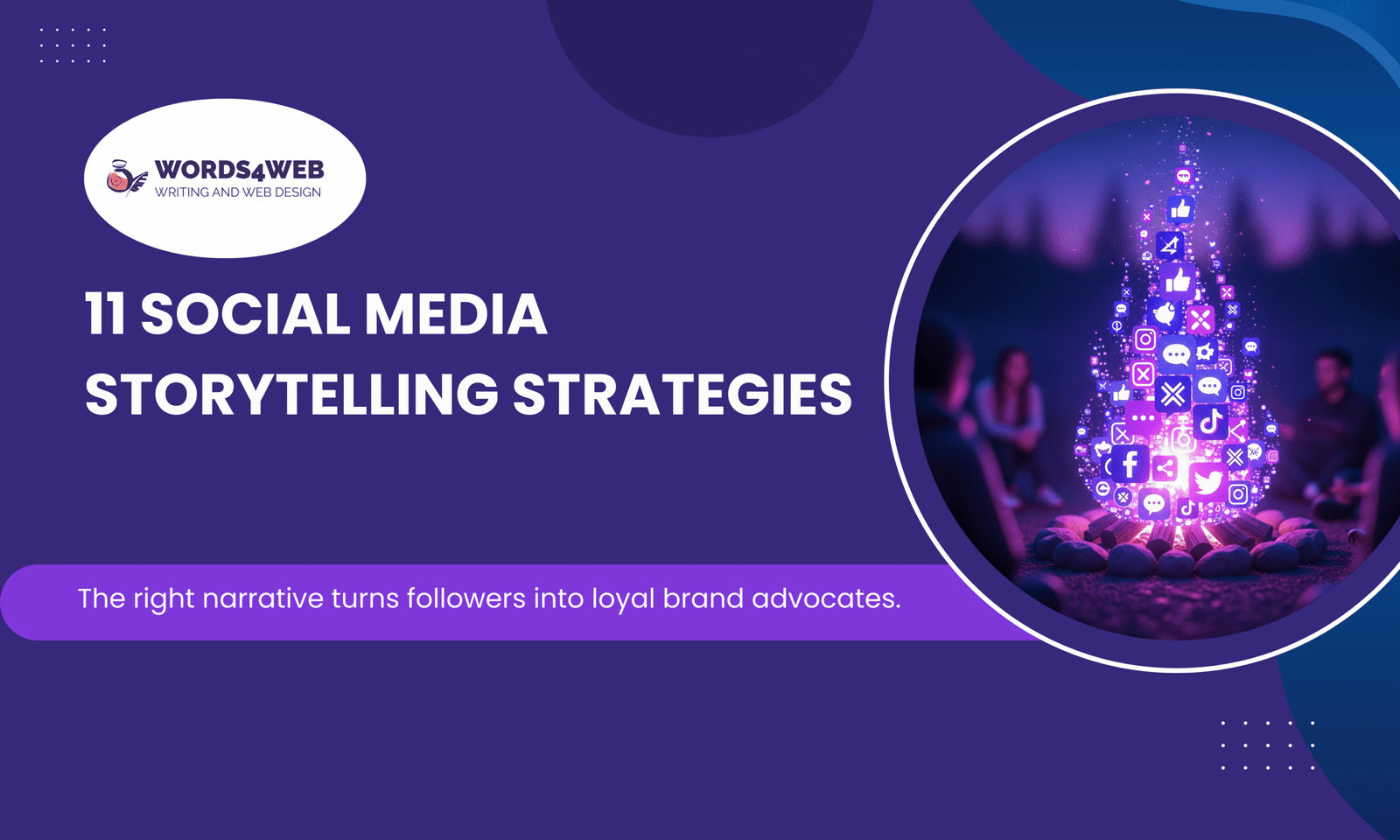11 Ways to Use Social Media for Storytelling That Will Make Your Audience Beg for More
If your posts aren’t getting saves, shares, or replies, you don’t need more content; you need better stories. Use these 11 ways to turn casual scrollers into engaged followers.
Any form of social media storytelling is not just for the big brands with millions of dollars in their marketing budget. It’s for anyone who wants to connect, engage, and build authentic online relationships. Want to turn boring social media into unforgettable? Let’s get after it!

Why Social Media Storytelling Works Like Magic
Here’s the thing about humans. We’re wired for stories. Since caveman days, we’ve gathered around fires sharing tales. Social media is just our modern campfire. Stories make us feel connected, remember better, trust more, and take action. When you tell stories on social media, you’re not just posting content. You’re creating experiences.
1. Share Your Origin Story
Everyone loves an origin story. How’d you get started? What sparked you? Your origin story doesn’t have to be dramatic. It just has to be just specific and true. Maybe you opened your bakery because Grandma’s pie recipe was too good to keep secret. Or perhaps you became a coach after pulling yourself up from a personal low point.
When you share the real story behind your journey, you give people a reason to care and a reason to trust you.
2. Use Behind-the-Scenes Content
Pull back the curtain. Show the messy parts. The failed attempts. The 3 AM moments. Behind-the-scenes content works because it feels exclusive, like you’re letting people into your inner circle. Recording yourself getting ready for a meeting, laughing about a mistake you made, or celebrating a tiny win all make your brand relatable.
Show process over polish, mistakes included, but keep private/client-sensitive details off camera. Perfect is boring, and the audience loves real over-polished.
Example: Create a Reel with 5 quick clips showing your journey from idea → draft → feedback → revision → publish, and add a caption that highlights what changed at each step.
3. Create Customer Success Stories
Your customers tell the best stories. Their victories become your victories. Their transformations become your proof. Rather than just saying “our product works,” show it in action through their journey.
A simple way to structure these stories is:
- Before – Where was the customer starting from?
- Barrier – What challenge or pain point held them back?
- Action – How did they use your product/service to overcome it?
- After (Metric) – What tangible result did they achieve? (saves, growth, sales, confidence, etc.)
- Lesson – What insight or takeaway can others learn from their journey
Example: “Before using our scheduling tool, Sarah was spending 10+ hours a week manually planning posts. The barrier? She felt overwhelmed and always behind. After switching, she batched her content in 2 hours and grew engagement by 35%. Her lesson: planning ahead creates freedom, not restriction.”
Always remember to get permission before sharing customer stories; privacy builds trust just as much as the success itself.
4. Use Visual Storytelling Techniques
A picture may be worth a thousand words, but the right picture tells the right thousand. Visual storytelling isn’t about pretty photos; it’s about images that move the story forward.
Focus on formats that make your narrative easy to follow:
- Carousels – Great for step-by-step sequences or storytelling arcs.
- Split-Screen – Perfect for before/after transformations.
- Day-in-the-Life – A series of photos or clips that create a natural narrative arc.
Prompt/Example for a Carousel Story:
- Slide 1 (Hook): Grab attention with a bold statement or visual.
- Slides 2–4 (Setup): Show the context or problem.
- Slide 5 (Tension): Highlight the struggle or challenge.
- Slide 6 (Payoff): Reveal the solution or outcome.
- Slide 7 (CTA): Invite action—“What’s your version of this?” / “Try this today.”
Visuals become more powerful when they connect with emotion. Don’t be afraid to show the messy middle or vulnerable moments; they humanize your story. Just remember: share authentically, but not excessively.
5. Share Personal Struggles and Wins
Vulnerability creates connection. When you open up about your difficulties, you invite others to see the real human behind the brand. The key is balance: be honest, but keep medical, financial, or third-party details private.
A simple approach is:
- Share the challenge you faced.
- Highlight the one thing you changed that helped you move forward.
- Show the outcome, even if it’s a small step, not a giant victory.
This makes your story relatable without oversharing. For example:
“I was drowning in tasks and felt like I’d never catch up. Then I started blocking 90 minutes for deep work each morning. That one shift gave me focus, and I finally finished the project I’d been putting off.”
Your audience doesn’t need a moral science lesson, they just need to see that progress is possible, even through small, imperfect steps.
6. Create Series and Episodic Content
Keep them coming back for more. Series content is like a TV show for your brand, people tune in regularly to see what happens next, creating a habit around your posts.
Popular series formats include “Monday Motivation” posts, “Wisdom Wednesday” tips, weekly progress updates, or monthly challenges. The key is durability: commit to a cadence you can actually keep (e.g., once a week instead of daily).
To make your series stick:
- Name it – Give your series a clear identity (e.g., “Creator’s Corner” or “30 Days of Growth”).
- Number the episodes – Label them (Episode 1, Week 3, Part 5) so people can save, track, and binge your content later.
- Stay consistent – Missing an episode breaks trust. Pick a rhythm you can sustain long-term.
When you create a series, you’re not just posting, but you’re building anticipation.
7. Use User-Generated Content
Allow your community to be your messenger. User-generated content (UGC) is powerful because it’s not you talking about yourself; it’s real people sharing their genuine experiences with your brand. That kind of authenticity builds instant trust.
Here’s how to make UGC work for you:
- Create a branded hashtag – Make it easy for people to share and for you to find their content.
- Pin a “Best of UGC” highlight – Showcase your favorite community stories on Instagram, TikTok, or Facebook so new followers instantly see proof of your community.
- DM for consent: Always respect privacy. Use a simple message template like:
“Hi [Name], we loved your post and would like to feature it on our page with credit to you. Is that okay?”
Facilitate content by running photo contests, asking clients for stories, and promoting their posts when they tag you. And always acknowledge the creator with a thank-you, tag, or shout-out; recognition fuels more participation.
8. Tell Stories Through Live Videos
Live video has a sense of realness and immediacy you can’t reproduce in a polished recording. The pauses, small mistakes, and instant audience reactions make it authentic, exactly the kind of storytelling people crave.
Use live sessions for:
- Q&A – Answer questions while weaving in stories.
- Behind-the-scenes – Share moments as they happen.
- Announcements – Reveal updates or launches in real time.
- Casual chats – Create space for conversation, not just broadcasting.
Don’t aim for perfection. The power of live video isn’t polish—it’s presence.
9. Create Interactive Stories
Interactive content turns your audience from passive viewers into active participants in your brand’s story. Polls, quizzes, and Q&As don’t just engage; they create connection. Use polls to validate products or angles, quizzes to segment your audience, and Q&As to build a content backlog. On Instagram and Facebook, these features make people feel heard and invested, deepening their bond with your brand.
10. Share Transformation Stories
Everyone loves a good transformation story, but it doesn’t have to be a dramatic weight loss or overnight success. Any positive change counts and can inspire your audience to make their own.
Transformation stories work because they offer hope. They show what’s possible when someone commits to growth. Go beyond the “before vs. after” glow-up. Show the process.
Here’s a simple structure:
- Timeline: When did the change start, and how long did it take?
- Decisions: What key choices or pivots shaped the journey?
- Metrics: What measurable shifts happened along the way (sales, hours saved, confidence levels, skills learned)?
Examples:
- A freelancer growing from 1 to 10 clients in six months by raising rates and niching down.
- A community group doubled its attendance after shifting meetings from evenings to mornings.
The real story isn’t just the outcome. it’s the steps, struggles, and lessons that made the outcome possible.
11. Use Storytelling in Your Captions
The caption is your stage where the real storytelling magic happens. Your image grabs attention, but your caption keeps people reading, feeling, and responding.
A strong storytelling caption follows a simple framework:
- Hook – Grab attention with curiosity or tension.
- Setup – Provide context: what was happening, what was at stake?
- Specifics – Share concrete details that make the story real.
- Shift (Insight) – Reveal the turning point, lesson, or aha-moment.
- CTA – End with a question or call-to-action to spark engagement.
Examples:
- “Three years ago, I couldn’t land a single client. Today, here’s what finally worked…”
- “This almost ended it all until we tried one small shift that changed everything. Want to know what it was?”
This framework keeps your captions consistent, engaging, and memorable without having to start from scratch every time.
Conclusion- Making It All Work Together
Here’s the secret sauce: these techniques work best when they work together. Your origin story leads into behind-the-scenes content. Customer stories connect to transformation narratives. Everything builds into a cohesive brand story.
Try creating a simple storytelling calendar: Monday motivation (personal struggles/wins), Wednesday behind-the-scenes, Friday customer spotlights. Stay flexible—real stories always beat planned ones.
Social media storytelling isn’t about perfection. It’s about connection. Every post is a chance to build a bridge between you and your audience. Start small, pick one technique, and build from there. Soon, people will be waiting for the next chapter in your story.
Now it’s your turn: which method will you try first? Remember, the most impactful story is the one only you can tell.
Ready for a storytelling system, not random posts?
- Get our free 7-Day Story Series Planner and see exactly how we plan hooks, arcs, and CTAs.
- Or book a 20-minute Storytelling Audit, and we’ll map your next 30 days of story posts together.
Great storytelling deserves great execution. Let’s make your success story the next one worth telling.





